Spielberg: The Adventures of Tintin part 7
Tintin and Haddock journey by camel to Bagghar, getting there just ahead of Sakharine in the Karaboudjan. Where are we now, in the structure of The Adventures of Tintin? Good question. Timing-wise, the grand transition from Tintin and Haddock in the legionnaire’s camp to them arriving in Bagghar falls at 1:12:00, with 34 minutes left to go in the movie. Given an assumption of acts of equal length, that would make the move to Bagghar a natural move into Act III. But don’t forget, act breaks are not about location or transition, but about the journey of the protagonist. In Act I, Tintin became embroiled in a mystery that led him to be taken aboard the Karaboudjan, an irreversible direction, led to by a choice but not a choice in and of itself (although Tintin would have surely tried to sneak onto the Karaboudjan on his own, given the opportunity). Act II is then divided into three parts, typical of Spielberg: meeting Haddock, travelling with Haddock, and acting with Haddock. The entrance into Bagghar is only the beginning of that third chapter of Act II. And, as we’ll see, the traditional end-of-Act-II low point, where the protagonist has lost everything “but there was one thing he’d forgotten,” comes with a mere 14 minutes left in narrative. All of Tintin is brisk, but that’s super brisk for Spielberg. And yet, it’s not necessarily brisk for animation — many classics, for whatever reason, dating back to Snow White and the Seven Dwarfs, follow what Jeffrey Katzenberg once explained to me as a “10-10-4” structure: 10 beats in Act I, 10 beats to Act II, 4 beats to Act III, Act III being, as Katzenberg described it, “a race to the finish line.”
Tintin and Haddock move through the crowded, alien streets of Bagghar, haunted by the ghosts of the marketplace-chase of Raiders of the Lost Ark, then haunted by Thomson and Thompson, who have come, disguised as Arabs, to deliver Tintin’s wallet to him, giving him the scroll he needs to even the odds between him and Sakharine. Tintin, at this point, has surpassed his role as journalist, he’s gotten involved in the story he’s chasing. As I’ve noted before, Tintin is a journalist who routinely becomes his own story. Hunter Thompson would later define this technique as “Gonzo journalism,” but for Tintin the story is his whole identity, he has no life outside it.
Enter Bianca Castafiore, “The Milanese Nightingale,” here first seen upside-down through a portraitist’s lens, and reminding us again that Tintin is a text seen through a different kind of lens. All the principals of Tintin are introduced in distorted ways: Tintin is first seen through his Herge portrait, Thomson and Thompson through the framework of a newspaper, Haddock through an empty bottle, now Bianca Castafiore through a camera, all to remind us that Spielberg is seeing Herge through a lens as well, and that Herge was seeing boys-adventure stories through his own lens. (“What a dish!” cries Haddock when he sees a picture of Castafiore, the only mention in the narrative of a character responding sexually to, well, anything.) Sakharine has brought Castafiore to Bagghar (via a separate route than the Karaboudjan, apparently) to stage a concert for the sultan, where Castafiore will sing a note that will break the bullet-proof glass of the case holding the final model of the Unicorn. That this plan is absurdly complicated is beside the point.
Tintin gives his scroll to Haddock to protect, and Haddock responds as though Tintin has just asked him to marry him — terrified, then grateful. Terrified because it means responsibility, to both Tintin and his family; grateful because Tintin has placed faith in him, and connected him to his family. From the look on Haddock’s face, we can already tell that he’s going to screw this up.
Tintin goes to Castafiore’s recital and spies the Unicorn model nearby. Spielberg gives us two sets of lenses for this final puzzle piece: the bullet-proof glass and Tintin’s opera glasses. Haddock, although smitten with Castafiore, cannot abide the sound of her voice (neither can Snowy). Haddock abandons ship, so to speak, and goes to take a drink from a bottle he’s secreted in his pocket. Taking out the bottle sends the Unicorn scroll flying, and there’s a beat where Haddock holds the scroll in one hand, the bottle in the other, trying to decide which impulse to honor: to drink, and retreat, or to put the bottle down and face his responsibilities. The point is moot, because Sakharine’s thugs kosh him with the bottle and take the scroll. Meanwhile, at the recital, Castafiore hits her high notes, breaking all the glass in the sultan’s palace, in an orgy of lens-shattering. All hell breaks loose: Sakharine’s falcon (he’s got a falcon) snatches the last scroll from the Unicorn model, people scream and run, Haddock confesses to Tintin that he’s lost his scroll, and Tintin’s faith in Haddock, like all the glass in the sultan’s palace, is shattered.
This conflagration propels the great setpiece capping Act II, the chase down the mountainside to the docks. If this had been shot in live action it would be, hands down, the most astoundingly complicated sequence in history — stemming from story, rooted in character and geography and location, full of wit and dazzling physical comedy, dotted with dozens of trade-offs and constantly-changing stakes, irreversibly altering the narrative as it progresses to its end, and containing what is probably the most amazing single tracking shot in Spielberg’s career (which is saying a lot), and impossible to create without computer-generated 3D animation, it alone justifies the movie’s existence and should be studied by film students as an example of what an “action beat” should accomplish.
Tintin gets the scrolls in his hand, and now has his Haddock moment, where he must make a choice between his obsession (the secret of the Unicorn) and his responsibilities to those in his care (Haddock, and, almost parenthetically, Snowy). Tintin tries to split the difference, hanging onto the scrolls long enough to read the numbers that come through when the scrolls are held together against the sun, and Sakharine responds by throwing Haddock off the dock. This, then, is the end-of-Act-II low point: all the scrolls are gone, and Tintin is left with nothing but responsibilities — a boy-adventurer’s nightmare.
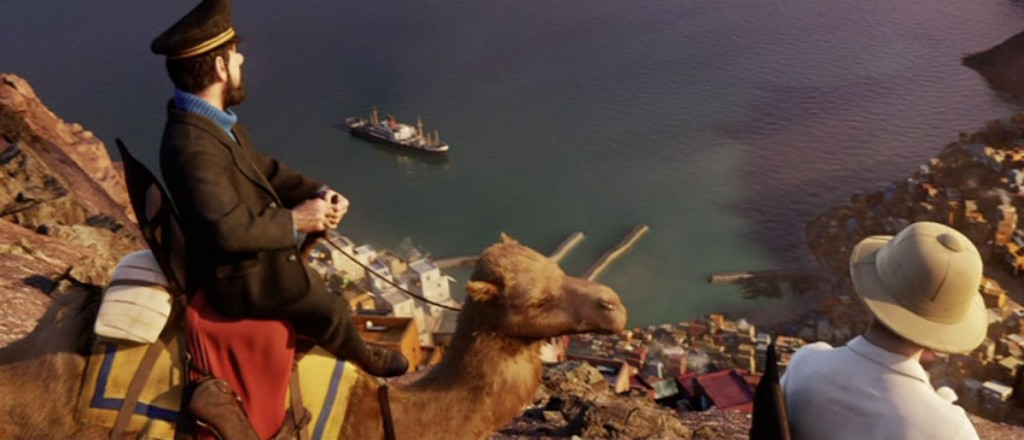
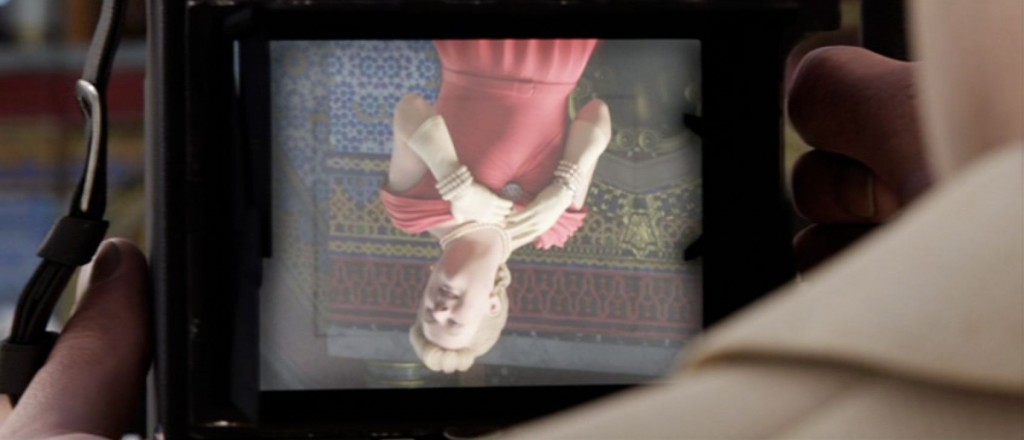
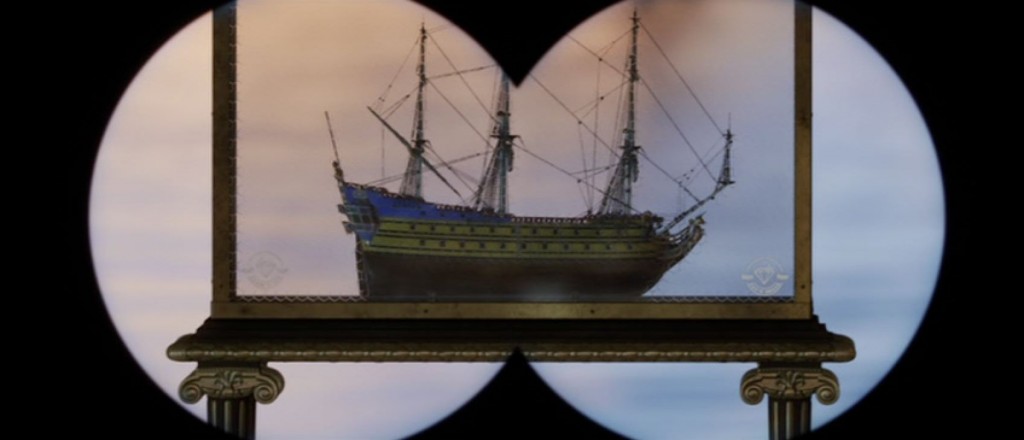
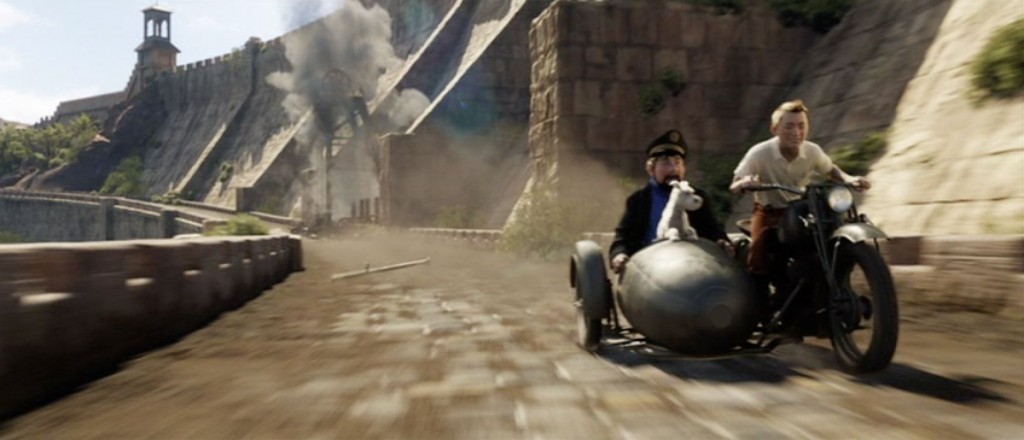
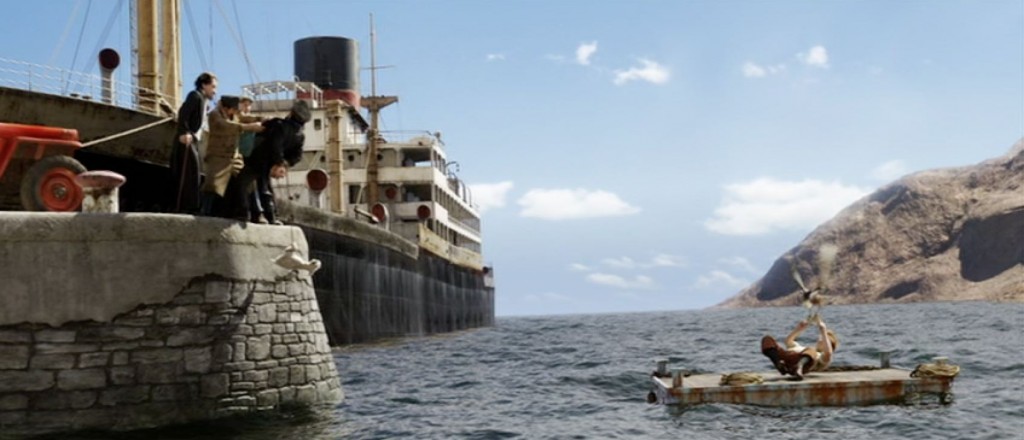
1) I didn’t see this movie in the theaters, and I almost can’t imagine watching the Bagghar chase scene on a big screen because of how breathless it is. I watched this first on the DVD with my girlfriend, who didn’t love it; so I woke up early the next day to rewatch this chase scene by myself with a lot of rewinding and tracking.
It’s interesting how the chase tracks certain elements and leaves others to the viewer to fill in. For instance, when we see the jeep/motorcycle chase from the palace, the long shot shows us the palace’s tanks (and the dammed lake), so when we see the tank later, we know where it came from–but not exactly how it got there. (Also for the viewer to fill in: why Omar ben Salaad is no longer chasing Tintin after the chase.)
2) Following your dictum that Spielberg turns ideas on their head, I’d like to add Haddock + bottle to the list: Haddock is taken out of action by a bottle of alcohol, only not the way we expect.
(Or put into structural terms, someone is either (1) hitting with a bottle, (2) being hit with a bottle, or (3) preventing someone from being hit with a bottle. We’ve seen (3) on the Karaboudjan, where Haddock takes the bottle out of Tintin’s hand when he’s about to knock out a guard. And now we’ve seen Haddock in the (2) role, so all we need is for Haddock to try (1)–turning the bottle into a weapon against someone other than himself.)
This chase is one of those moments when it seems that Spielberg got just a little bit too clever for his own good. The fact that all the stuff you mention happens in the deep background and is only glimpsed in the final film suggests that the chase was storyboarded in the classic Spielberg-adventure mode with cuts from subject to subject and was intended to be completed with his usual impeccable visual storytelling, but, somewhere along the way, he noticed that with CG animation it was possible to do the chase in one traveling shot. What gets lost are a lot of things which would have made the action clearer and the tiny storyline with the tank & the hotel.
As it stands, when the tank rolls up at the end, it’s a punchline to a joke where we never get to properly see the setup.
I know that the analysis on this blog is mostly about the screenplay/story, but I think that a lot of “The Adventures of Tintin” is undermined by some questionable directorial choices like this one. The focus should be on the story, but there’s all kinds of visual trickery and cleverness going on instead. It’s unusual to see Spielberg experiment (and not quite succeed) like this.
It’s true that Tintin feels light, that Spielberg is having fun first and perhaps wasn’t as engaged with the story as with, say, E.T., but at this point in his career, when movies like Munich and Lincoln are the norm for him, I grant him this happy escape into the past.
Todd, you mention here that “Act II is then divided into three parts, typical of Spielberg”. You’ve gone on record (or maybe I remember incorrectly) saying that Spielberg’s narratives are usually broken into 4 or even 5 acts, even pointing out the rare instances where he employs a 3 act structure.
So where do you stand on this matter right now? Are his 5 act structures just 3 act structures where the second act is divided into separate beats? I still can’t think of something like, say, Catch Me If You Can as anything other than a 4 act movie.
I was thinking specifically of the Indiana Jones movies, which are four acts with each act divided into three distinct chapters. The second act of Tintin, like, say, Raiders, has three distinct chapters to it: Meeting Haddock, Traveling with Haddock, Acting with Haddock.